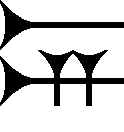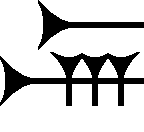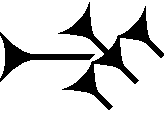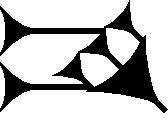
The cuneiform lu sign is a common, multi-use sign, a syllabic for lu, and an alphabetic sign used for l, or u; it has many other sub-uses, as seen in the Epic of Gilgamesh over hundreds of years, and the 1350 BC Amarna letters. Its other uses show other syllabic and alphabetic forms that it can be used for: other vowels, or consonants;. There are also four sumerogrammic sub-forms for "lu" in the Epic of Gilgamesh, LU, and UDU, and DAB and DIB; LU transposes to Akkadian language, "lullû", for English language, (primitive) man; DAB transposes to ṣabātu, English for to seize, capture.

The cuneiform sign 𒀀 for a, and in the Epic of Gilgamesh the sumerogram A, Akkadian for mû, "water", which is used in the Gilgamesh flood myth, Chapter XI of the Epic, or other passages. The sign is also used extensively in the Amarna letters.

The cuneiform sign for the syllable ab also represents that for ap, or the vowel and consonant usages of a, b, or p: in the Akkadian language "b" is unaspirated, formed with the lips, and "p" is aspirated, with the breath). In the Akkadian language "b" and "p" are interchangeable; also, in cuneiform texts, any vowel can be interchanged with any other. The ab/ap sign also has a corresponding capital letter (majuscule) usage as a sumerogram, as found in the Epic of Gilgamesh for AB, the Akkadian language for šību, meaning "elder".

The cuneiform šu sign is a common, multi-use syllabic and alphabetic sign for šu, š, and u; it has a subsidiary usage for syllabic qat; it also has a majuscule-(capital letter) Sumerogram usage for ŠU, for Akkadian language "qātu", the word for "hand". The human hand is the shape of cuneiform character šu, and thus the origin of its creation.

The cuneiform mi, sign is a distinctive sign in the wedge-stroke group, and is used as a syllabic for mi, me, and an alphabetic for m, i, or e; it is also a Sumerogram for MI, used for Akkadian language, "mūšu", night. MI, in the Epic of Gilgamesh, is used in (Chapters) Tablets I, II, III, and XII as either MI, or MI.MEŠ, a total of six times; other spellings of mūšu in other sections are alphabetic/syllabic, four times.

The cuneiform ŠEŠ sign, as a capital letter (majuscule), is a Sumerogram for Akkadian language ahu, for "brother". It is the cuneiform sign for ŠEŠ, as it can be used for a variety of lower case syllabic values, using š + vowel + š,. Sumerogram ŠEŠ has a high usage in the mid-14th century BC, ~1350-1330 BC Amarna letters from the brother kingdoms to the Pharaoh's Egypt. The brother kingdoms were Babylon, Alashiya, and Mittanni, where King Tushratta authored 13 El Amarna letters.

The cuneiform na sign is a common, multi-use sign, a syllabic for na, and an alphabetic sign used for n, or a; it is common in both the Epic of Gilgamesh over hundreds of years, and the 1350 BC Amarna letters. In the Epic of Gilgamesh it also has sumerogramic usage for NA. An example usage for NA in the Epic is for the spelling of NA.GAD,, for Akkadian language "nāqidu", "herdsman". The usage for NA in herdsman is only for 3 spellings.

The cuneiform sign ni is a common-use sign of the Amarna letters, the Epic of Gilgamesh, and other cuneiform texts. It has a secondary sub-use in the Amarna letters for addressing the Pharaoh, from the vassal states of Canaan. The address to the Pharaoh is often 'King-Lord-Mine': LUGAL, EN-ia which has many varieties of expression. "LUGAL" is Akkadian language for "Šarru", English "king", and EN in Akkadian is bēlu, for "Lord",. In some Amarna letters the sub-use of ni is lí, for spelling "bēlu", be-lí often .

The cuneiform giš sign,, is a common, multi-use sign, in the Epic of Gilgamesh, the Amarna letters, and other cuneiform texts. It also has a major usage as a sumerogram, GIŠ, for English language "wood", and is used as a determinative at the beginning of words, for items made of wood. The 12 Chapters (Tablets) of the Epic of Gilgamesh lists 16 named items beginning with "GIŠ".

The cuneiform di sign, also de, ṭe, ṭi, and sumerograms DI and SÁ is a common-use sign of the Epic of Gilgamesh, the 1350 BC Amarna letters, and other cuneiform texts. In the Akkadian language for forming words, it can be used syllabically for: de, di, ṭe, and ṭi; also alphabetically for letters d, ṭ, e, or i. Some consonant-pairs (d/t), are also interchangeable.

The cuneiform du sign, also kup, and sumerograms DU and GUB, is a common-use sign of the Epic of Gilgamesh, the 1350 BC Amarna letters, and other cuneiform texts. In the Akkadian language for forming words, it can be used syllabically for: du, or kup ; also alphabetically for letters d, u, k, or p. It is also true in the Akkadian language, that some consonants are paired, thus the relationship between kup, and sumerogram GUB is explained (k/G).

The cuneiform sa sign is a less common-use sign of the Epic of Gilgamesh, the 1350 BC Amarna letters, and other cuneiform texts. It also has a sumerogrammic usage for SA in the Epic of Gilgamesh. The structure of the cuneiform sign is similar to, Ir (cuneiform), .

The cuneiform sign za is a common use sign in the Amarna letters and the Epic of Gilgamesh. It is used syllabically for ṣa, za, and ZA, and alphabetically for "ṣ" (s), "z", or "a".

The cuneiform sign ba, is a common-use sign of the Amarna letters, the Epic of Gilgamesh, and other cuneiform texts.

The cuneiform sign mu, is a common-use sign of the Amarna letters, the Epic of Gilgamesh, and other cuneiform texts. It is also used as MU.

The cuneiform sign am, is a common-use sign of the Amarna letters, the Epic of Gilgamesh, and other cuneiform texts. It is also used as AM.

The cuneiform gi sign is a common multi-use sign of the Epic of Gilgamesh, the 1350 BC Amarna letters, and other cuneiform texts. It also has a sumerogrammic usage for GI in the Epic of Gilgamesh. The structure of the cuneiform sign is like its twin, Zi (cuneiform), .

The cuneiform zi sign is a common multi-use sign of the Epic of Gilgamesh, the 1350 BC Amarna letters, and other cuneiform texts. It also has a sumerogrammic usage for ZI in the Epic of Gilgamesh. The structure of the cuneiform sign is like its twin, Gi (cuneiform), .

The cuneiform sign iš is a common use sign in the Amarna letters and the Epic of Gilgamesh. It is used syllabically for iš; also for mel, mil, and a Sumerogramic usage for IŠ. Alphabetically as "iš", its most common usage, it can be used for "i" or "š". In Akkadian, the four vowels a, e, i, o, are all interchangeable, and the three different "s", can also be interchanged: s, ṣ, š.

The cuneiform sign hal, is a common-use sign in the Epic of Gilgamesh, the Amarna letters, and other cuneiform texts, for example Hittite texts. Its common usage is syllabic for hal, but could also be use for alphabetic h or l, or the a, and for the other three vowels of e, i, or u.



















